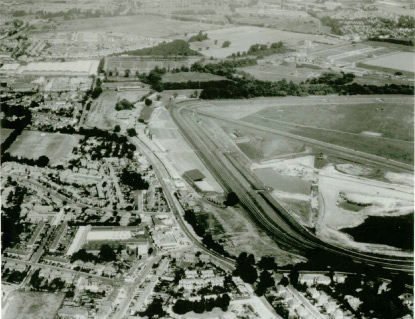With all the current controversy about the future of Kempton Park Racecourse, I thought it would be a good time to look back over the history of the site.
It may come as a surprise to hear that it was once the site of a royal palace, long before its nearby neighbour at Hampton Court.
In 1086 the manor of Kempton was recorded in Domesday Book as belonging to the William the Conqueror’s half-brother, Robert Earl of Mortain, although as one of many estates he probably never lived there. After Robert’s son William rebelled against Henry I in 1104, the manor was forfeited to the Crown.
It was let to various tenants for services rendered over the years, until in 1223 Henry III took it into Crown ownership again. It was no doubt a convenient stopping point between Westminster and Windsor, and a base for hunting deer. After the death of Henry, Edward I used Kempton occasionally, and restocked the park with deer, but thereafter the Manor was again leased out to various Crown retainers.
Henry VIII incorporated Kempton into his large ‘Honour of Hampton Court’ estate in 1509. In the time of Queen Elizabeth I it was leased to the Killigrews, a well-known Cornish family, and in 1640 a family connection led to Carew Raleigh, son of Sir Walter, living there. By 1665 it was in the possession of Francis Phelips, who was also Lord of the Manor of Sunbury. He was buried in the old church at Sunbury, and his memorial may still be seen inside the present church. A 1692 plan of the estate shows a three storey house with a central tower, topped by a cupola.
Grand avenues of trees radiated out from the house. The Musgrave family lived at the house in the latter half of the 18th century, but by the early 19th century it had been rebuilt in the fashionable Gothic revival style of nearby Strawberry Hill House, for John Fish. This house was demolished for its materials after Fish’s death in 1815, but a suite of elaborate furniture from it is preserved at the Royal Pavilion in Brighton. In 1864 it was acquired by Thomas Barnett and Peregrine Birch, who in a foretaste of today planned to build houses on part of the estate, but in the event only a few were built along the Hampton Road.
In 1876 Samuel Hyde leased the estate for his new racecourse. The first meeting was held at the new racecourse on July 18th, 1878, and for over a century it has been one of the country’s premier courses. What a shame it would be for all this history and open land to disappear.
To learn more about the history of Kempton Park, see ‘The Royal Manor of Kempton’, published by Sunbury and Shepperton Local History Society. The next Society talk is ‘The Restoration of the Temperate House at Kew Gardens’ by Sue Rhodes of Kew, at 8pm on Tues 21st March at Halliford School, Russell Road, Shepperton.
An aerial view of the old course at Kempton dating from 1971.

